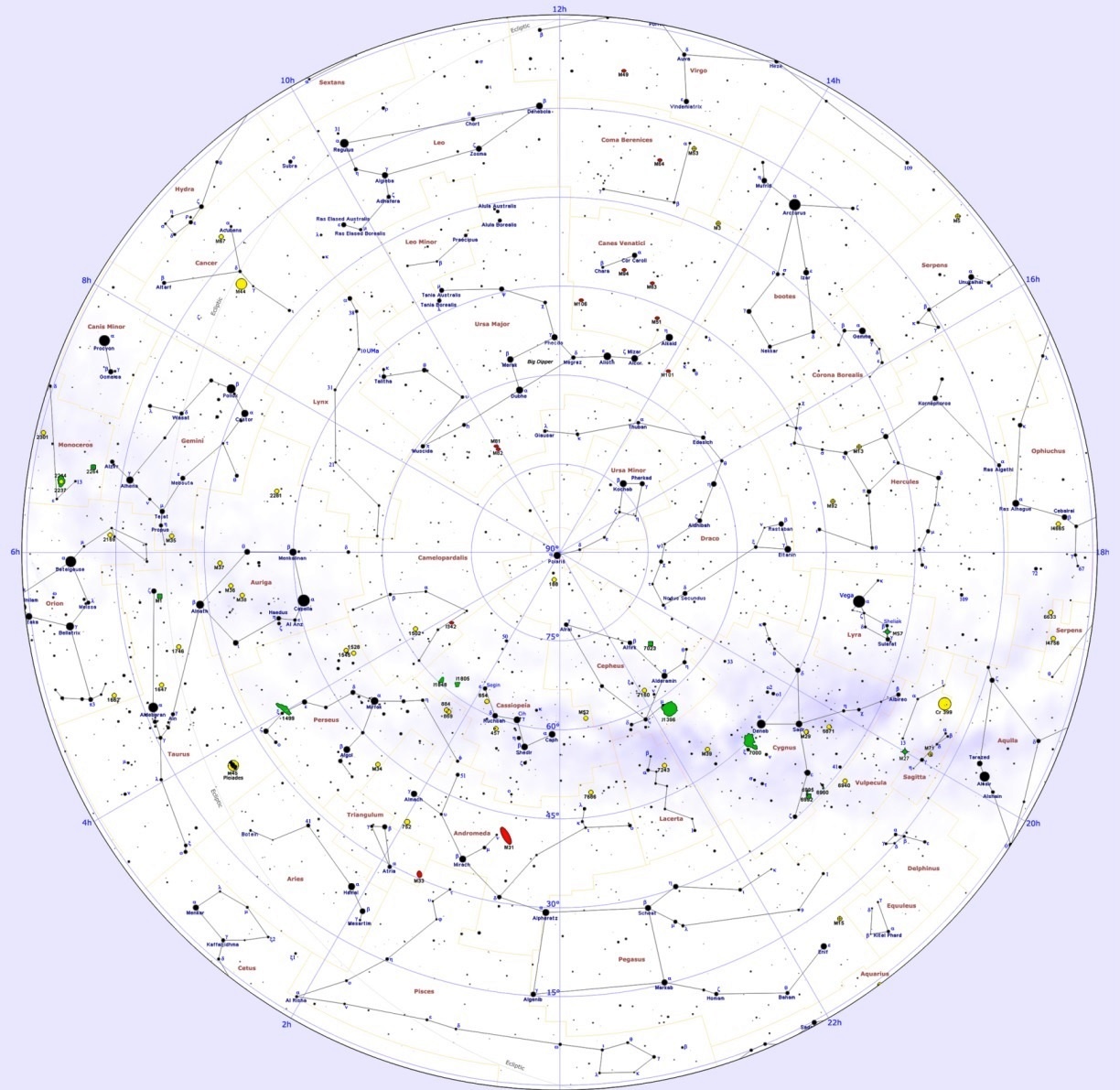Northern constellations are those found in the northern celestial hemisphere, located north of the celestial equator. These constellations are best seen from the northern hemisphere, where they appear higher above the horizon in the night sky.
The best-known northern constellations are Ursa Major (the Great Bear), Ursa Minor (the Little Bear), Auriga (the Charioteer), Cygnus (the Swan), Cassiopeia (the Queen), Andromeda (the Princess), Pegasus (the Winged Horse), and Perseus.
Most of these constellations have relatively bright constellation figures and are dominated by prominent asterisms: the Big and Little Dippers, Auriga’s hexagon, the Northern Cross, Cassiopeia’s W, the Great Square of Pegasus, and the Segment of Perseus.
Fifteen constellations lie on the celestial equator (the projection of Earth’s equator into space). The equatorial constellations that appear predominantly in the northern celestial hemisphere are Aquila (the Eagle), Canis Minor (the Little Dog), Leo (the Lion), Orion (the Hunter), Pisces (the Fishes), Serpens (the Snake), and Taurus (the Bull). Monoceros (the Unicorn) is assigned to the second quadrant of the northern hemisphere, but most of the constellation lies south of the celestial equator.
Ursa Minor (the Little Bear) is the northernmost constellation in the sky. It is home to Polaris (the North Star), the nearest visible star to the north celestial pole. The constellation is largely invisible from the southern hemisphere.
Ursa Minor and the neighbouring constellations – Draco (the Dragon), Camelopardalis (the Giraffe), and Cepheus (the King) – can be spotted from the southern tropical latitudes, but they never rise very high in the sky for southern observers. The entire Ursa Minor is visible only from northern locations because Polaris stays below the horizon from locations south of the equator.
Known for the Big Dipper asterism, Ursa Major is the largest northern constellation and the third largest constellation in the sky, after Hydra and Virgo. Its bright stars Merak and Dubhe can be used to find Polaris in Ursa Minor. Polaris is part of the fainter Little Dipper and marks the end of the Little Bear’s tail.
Hercules and Pegasus, the second and third largest northern constellations, host two conspicuous rectangular asterisms known as the Keystone and the Great Square of Pegasus. The Keystone is best seen during the northern hemisphere summer, while the Great Square dominates the evening sky throughout the autumn months.
The bright stars of northern constellations form several other seasonal asterisms. Arcturus in Boötes (the Herdsman), the brightest star in the northern celestial hemisphere, forms the Spring Triangle with Regulus in Leo (the Lion) and Spica in Virgo (the Maiden). Arcturus and Spica form the Diamond of Virgo (the Great Diamond) with Denebola in Leo and Cor Caroli in Canes Venatici (the Hunting Dogs).
Deneb, Vega and Altair, the brightest stars of Cygnus (the Swan), Lyra (the Lyre) and Aquila (the Eagle) form the Summer Triangle. Deneb is also part of the Northern Cross, a prominent asterism formed by the brightest stars of Cygnus. These star patterns dominate the evening sky during the northern hemisphere summer.
The brightest winter asterisms are the Winter Circle (Winter Hexagon) and the Winter Triangle. Sirius, the lucida of Canis Major and the brightest star in Earth’s sky, is part of both. It forms the Winter Triangle with Procyon in Canis Minor and Betelgeuse in Orion, and the Winter Hexagon with Procyon, Pollux in Gemini, Capella in Auriga, Aldebaran in Taurus, and Rigel in Orion. Some of these stars, including Sirius and Rigel, lie south of the celestial equator.
The majority of the modern 36 northern constellations are based on the Greek constellations, first catalogued by the astronomer Ptolemy in the 2nd century CE. These constellations were visible from Greece in ancient times and observers associated them with Greek myths and legends.
Most of the Greek constellations, including the constellations of the zodiac, have a much longer history, going back to Babylonian times and some even to the Late Bronze Age.
Two entire constellation families are found in the northern sky.
The 10 constellations in the Ursa Major family all lie in the northern celestial hemisphere and can be seen rotating around the north celestial pole throughout the year from the northern latitudes.
These are Boötes (the Herdsman), Camelopardalis (the Giraffe), Canes Venatici (the Hunting Dogs), Coma Berenices (Berenice’s Hair), Corona Borealis (the Northern Crown), Draco (the Dragon), Leo Minor (the Smaller Lion), Lynx, Ursa Major (the Great Bear) and Ursa Minor (the Little Bear).
Similarly, all the constellations in the Perseus family except Cetus (the Whale) lie in the northern celestial hemisphere. These are Andromeda (the Princess), Auriga (the Charioteer), Cassiopeia (the Queen), Cepheus (the King), Lacerta (the Lizard), Pegasus (the Winged Horse), Perseus and Triangulum (the Triangle).
The largest northern constellations are Ursa Major (1279.66 square degrees), Hercules (1225.15), Pegasus (1120.79), Draco (1082.95), Leo (946.96), Boötes (906.83) and Pisces (889.42).
The smallest constellations in the northern sky are Equuleus (71.64 square degrees), Sagitta (79.93), Triangulum (131.85), Corona Borealis (178.71), and Canis Minor (183.37).
Below is the list of the constellations that lie (predominantly) in the northern celestial hemisphere. The northern celestial hemisphere is divided into four quadrants – NQ1, NQ2, NQ3, and NQ4 – and the 36 northern constellations are found within these quadrants.
Andromeda (NQ1)
Aries (NQ1)
Cassiopeia (NQ1)
Orion (NQ1)
Perseus (NQ1)
Pisces (NQ1)
Taurus (NQ1)
Triangulum (NQ1)
Auriga (NQ2)
Camelopardalis (NQ2)
Cancer (NQ2)
Canis Minor (NQ2)
Gemini (NQ2)
Leo (NQ2)
Leo Minor (NQ2)
Lynx (NQ2)
Monoceros (NQ2)
Ursa Major (NQ2)
Boötes (NQ3)
Canes Venatici (NQ3)
Coma Berenices (NQ3)
Corona Borealis (NQ3)
Draco (NQ3)
Hercules (NQ3)
Serpens (NQ3)
Ursa Minor (NQ3)
Aquila (NQ4)
Cepheus (NQ4)
Cygnus (NQ4)
Delphinus (NQ4)
Equuleus (NQ4)
Lacerta (NQ4)
Lyra (NQ4)
Pegasus (NQ4)
Sagitta (NQ4)
Vulpecula (NQ4)
